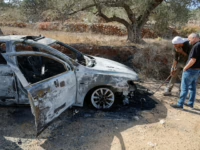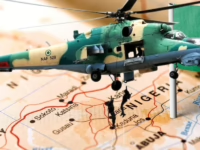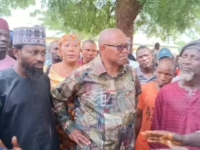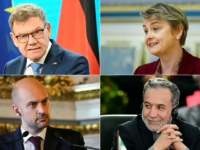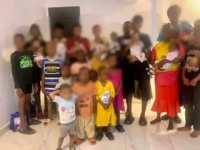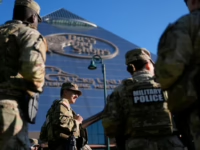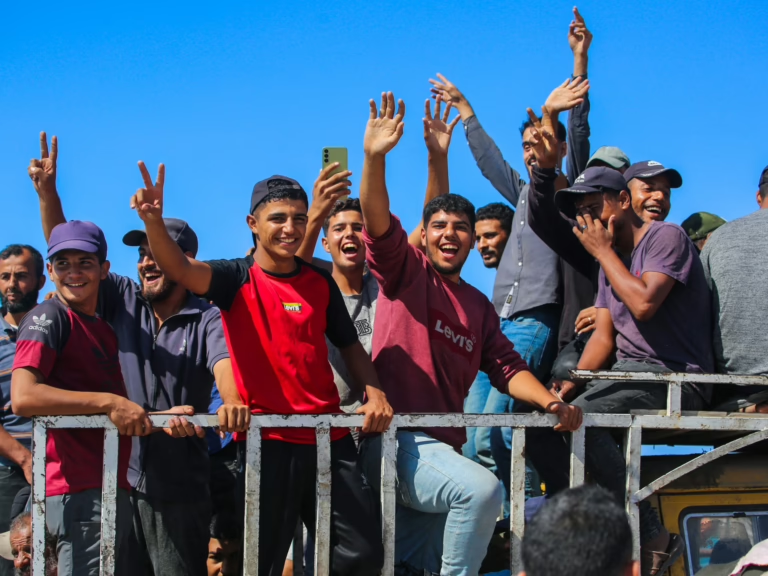Al-Mawasi, Gaza Strip – Amid the shifting sands of al-Mawasi, where rows of tents extend endlessly, 42-year-old Hanaa Abu Ismail knelt down to prepare a spot for her fire, a gentle smile crossing her face.
For the first time in over half a year, following Israel’s unilateral termination of the last Gaza ceasefire, the relentless sounds of conflict had finally ceased.
“No more hopelessness,” she declared, her voice rising above the murmurs of the displacement camp. “We crave happiness, to raise our voices again – the fighting has ended, and God willing, we will return home.”
The ceasefire, which took effect on Friday, has introduced a rare tranquility to Gaza. The usual drone surveillance has quieted, and the skies are free from warplanes. For Hanaa and the hundreds of thousands residing in al-Mawasi-a narrow coastal strip nestled between Deir el-Balah and Khan Younis that has become Gaza’s largest displacement camp-there is now a fragile, tentative glimpse of peace.
This ceasefire followed intense negotiations held earlier in the week in Egypt’s Sharm el-Sheikh, involving mediators from Qatar, Turkey, and the United States. The agreement, rooted in a 20-point framework unveiled by US President Donald Trump in late September, ended two years of continuous Israeli airstrikes that claimed over 67,190 Palestinian lives and forced nearly 90% of Gaza’s 2.1 million inhabitants to flee their homes.
Seated on the hard-packed earth beside her tent, Hanaa clapped along to a traditional Palestinian melody. The war, she shared, had uprooted her family at least 15 times over the past two years. Yet on this first day of ceasefire, she found a moment of serenity.
“My morning was peaceful,” she told Al Jazeera. “I kneaded dough, baked bread, and now I’m preparing the coals. Despite our wounds, we will find joy. If we are still alive, then we have already triumphed.”
Still, for many, the relief brought by the ceasefire was mixed with skepticism, as they awaited the promised humanitarian aid and reconstruction efforts to reach their tents.
Omar al-Dadda held his youngest son close, the boy’s sobs finally subsiding after more than thirty minutes of crying. The food from a nearby soup kitchen had been delayed once again-volunteers had to prepare a fresh batch after supplies ran out, pushing the wait another two hours.
“Hours have passed, and nothing has changed,” Omar told Al Jazeera, adjusting his hold on Rayan, his five-year-old son, with his one functioning arm-the other lost in a farming accident in 2015. “My children line up for food, fetch drinking water, and I search for assistance from relief organizations.”
For now, survival remains the only certainty.
‘The Final Harsh Days’
The United Nations reports that al-Mawasi’s population has surged from approximately 115,000 in mid-March to nearly 425,000 by June, with almost all residing in makeshift tents constructed from wood and plastic sheeting.
This influx has continued, fueled by new displacement orders and the exodus of nearly 200,000 people from Gaza City following Israel’s ground offensive in September.
Omar sat on a worn mattress outside his shelter, which was donated five months ago after he fled eastern Khan Younis. Around him, his four other children-Anas, 12; Minas, 10; Hamoudah, 8; and Sidra, 6-argued over who would fetch water from a truck parked 200 meters away.
Despite his disability, Omar lifted several water containers to assist his children, hoping to fill a small barrel before the truck departed or ran dry. His wife, Ibtissam, was busy cleaning kitchenware and airing bedding that had been dampened by morning fog.
“It pains me deeply to see my children, who should be attending nearby schools, instead spending their days searching for water and food,” he said. “This hardship breaks their spirits. They cry every day because of this life.”
Under the initial phase of the ceasefire, Israeli forces have reportedly withdrawn from densely populated areas, including Gaza City and Khan Younis. This pullback is intended to facilitate Hamas’s preparation to release 20 hostages, expected by Monday, according to Trump. Israel has also agreed to free 250 Palestinian prisoners serving life sentences, 1,700 others detained since the conflict began, and all women and children in custody.
Border crossings are set to reopen, with 400 trucks delivering aid on the first day and 600 expected daily thereafter. Unlike previous arrangements, international aid organizations-not the US- and Israel-backed Gaza Humanitarian Fund (GHF), criticized for its lack of neutrality and Israeli military oversight-will manage distribution. The road to the Rafah crossing with Egypt will also be accessible again.
Yet, these plans have yet to bring immediate relief to families like Omar’s. While he remains hopeful that aid will reach those in dire need, he acknowledges that meaningful change may take months.
“I just want to leave this harsh reality behind and start anew,” he said. “We pray that today marks the end of these cruel days and that our lives will slowly improve as the ceasefire unfolds.”
Others, like Hanaa, hold onto a brighter hope.
Her laughter echoed as she pulled her four-year-old daughter, Sila, onto her lap, while her grandchild Mohammad toddled nearby.
“For their sake,” she whispered, “we must smile and rebuild. This agreement means safety… and with safety, everything else can follow.”
Hanaa expressed a deep yearning to return to her home in Abasan, east of Khan Younis, even if it means setting up a tent amid the ruins.
“We just want to be near what was once ours,” she said. “To feel life beginning again.”
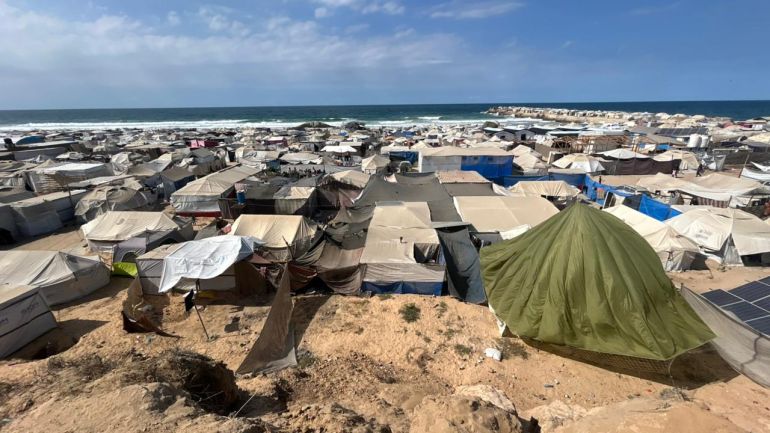
Contemplating the Return
Several kilometers south in central al-Mawasi, 55-year-old Essa Said spent Friday deliberating his family’s next steps: whether to stay in their tent and prepare for the approaching winter by reinforcing it with additional tarpaulin, or to return to their devastated home in the al-Rabouat area of eastern Khan Younis.
Locals say the neighborhood falls within zones where return will be permitted under the ceasefire. However, Essa and his wife, Amal, 49, remain deeply uncertain about the ceasefire’s longevity.
“We had partially repaired our damaged home before, only to see it completely destroyed by shelling two months ago,” Essa recounted. His family, including two sons-Mohammed and Ahmed, both doctors-and four daughters, two still in school, have wrestled with the risks of rebuilding only to face displacement again.
“The ceasefire offers a rare chance to rebuild and plan for the future,” he told Al Jazeera. “But our options are limited: endure harsh conditions here, or return to areas that may be even more dangerous, with no water, roads, or services.”
Ultimately, the family decided to return but will wait several days to evaluate the situation.
“We’ll be cautious for a few days or more to understand the conditions.”
As Amal prepared food and their daughters helped with cooking, Essa took the moment to buy traditional winter sweets-halaweh and awameh-calling to his wife by her kunyah (Arabic honorific) over the fire: “Um Ahmed, relief is near, God willing. Soon, we’ll stop using firewood and cook with gas. They say gas trucks will arrive shortly.”
Neither Essa nor Amal had slept the previous night, overwhelmed by joy.
“My wife wept several times, we embraced, and neighbors came to congratulate each other,” Essa recalled. “It felt like Eid, or even more. We haven’t experienced such happiness before.”
Their youngest daughter, Rahaf, spent two hours at a nearby field school before returning to review her lessons and then helped her sister Lian bake bread in a clay oven.
“We’re so happy about the ceasefire,” Rahaf said. “We want to go back to school, to our neighborhood, to reunite with neighbors from before the war. We’ve had enough fighting. We want peace.”
Looking Ahead
President Trump has promised the reconstruction of Gaza but has provided few specifics.
Meanwhile, United Nations Secretary-General Antonio Guterres vowed to “scale up the delivery of sustained and principled humanitarian aid” and to advance “recovery and rebuilding efforts.”
Omar hopes for improvements beyond immediate relief. “I want open roads, expanded water networks, caravans and mobile homes, lighting, and electricity,” he said. “These are urgent needs that will transform our lives.”
Essa’s priorities are more immediate.
“We hope for steady water supplies, consistent aid distribution, lower prices for fruits and vegetables, and the arrival of meat and other essentials that will improve our daily lives.”
Both men recognize the fragility of the moment-the uncertainty over whether the ceasefire will endure beyond its initial phase, whether promises will translate into action, and whether the silence overhead will persist.
As Friday evening settled, Hanaa sat with her family, looking toward the future with cautious optimism. “We are weary of smoke and ashes,” she said. “We want our old lives back, or at least something close to them.”










